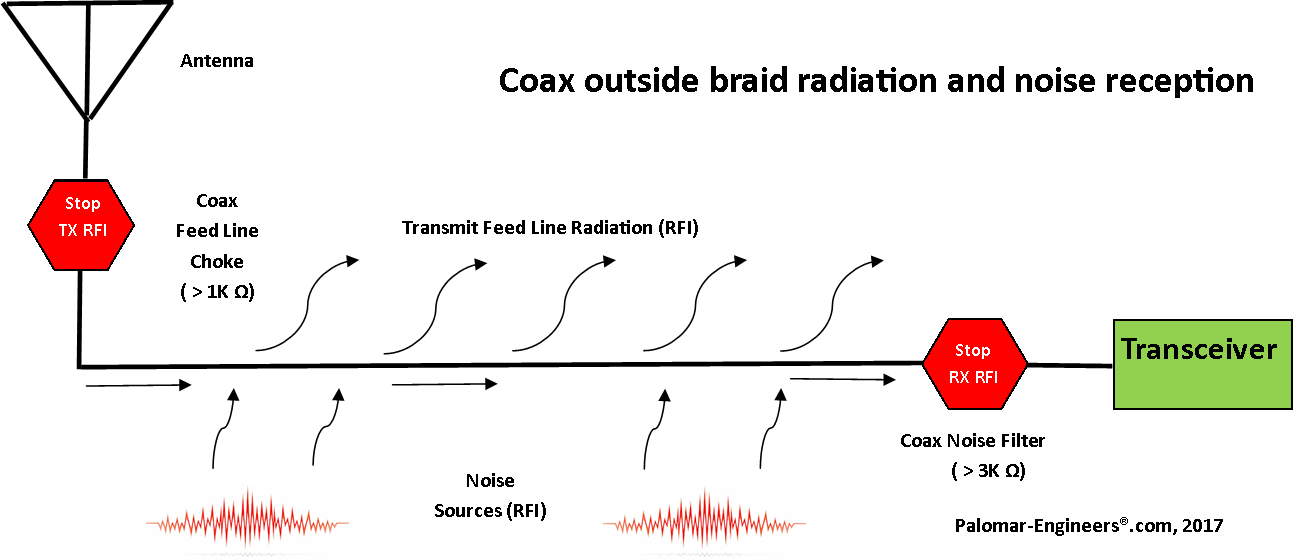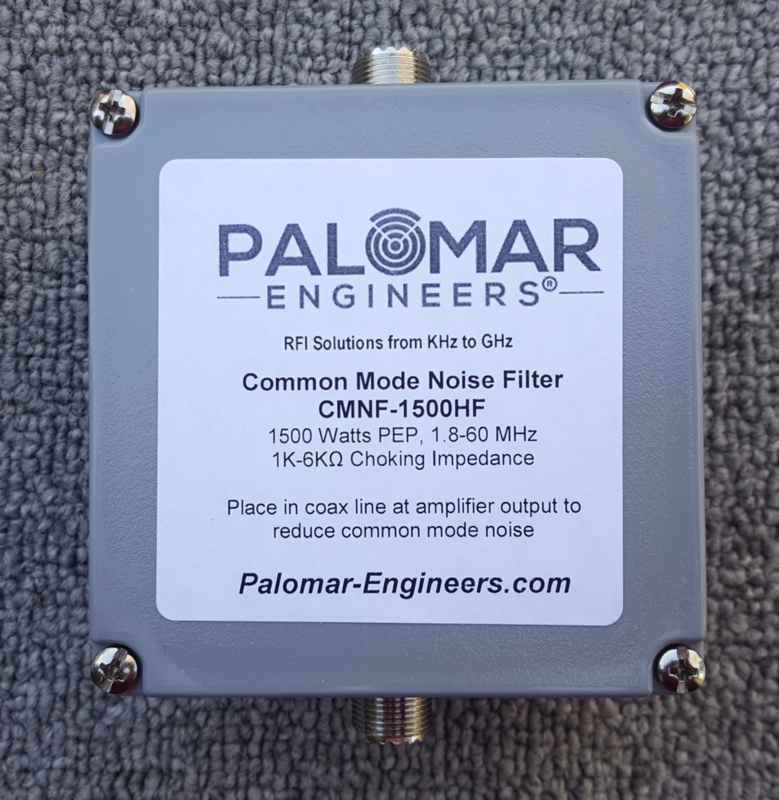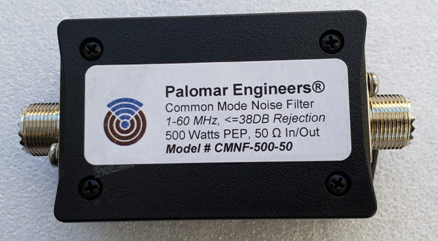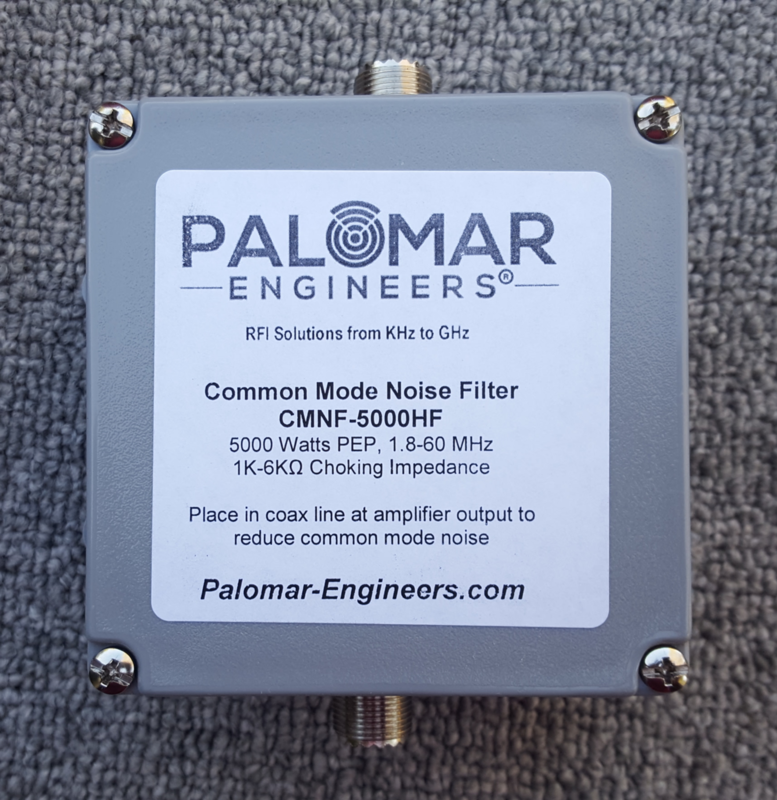Select your currency:
United States Dollar (USD)
Coax Noise Filters
The Problem:
Common mode current induced by radiated sources (plasma TV, routers, computers, transmitters, etc.) can be picked up by the outside of the coax braid from the antenna feed point back to the receiver. This portion of the coax braid acts like a second receiving antenna, picking up common mode noise signals that combine with weak signals (traveling down the center conductor and inside of the coax braid) making it difficult or impossible to hear weak signals! See diagram below.

The Solution:
A coax common mode noise filter with high choking impedance at the receiver/transceiver end of the coax effectively reduces common mode noise present on the coax braid while passing desired signals present on the coax center conductor. For best results, and to reduce co-interference between choked and un-choked feed lines with multiple antennas, EACH antenna feed line entering the radio room needs to have a coax noise filter even if it feeds a common coax switch since most antenna switches ONLY switch the center conductor of the coax line, yet all the coax braids are ALWAYS connected together in parallel.So when an antenna is NOT SELECTED, its coax sheath still contributes to the noise level of the connected antenna through the common connector ground!

The solution? A common mode noise filter with high choking impedance at the receiver end of the coax.
Do you have common mode noise on your coax?
Make this simple test to find out.
- Remove the coax connector and measure the noise level.
- Now insert the coax connector CENTER CONDUCTOR ONLY into the SO-239 antenna input and measure the noise level (it should be higher and include possible signals)
- Now connect the OUTER SHELL of the coax connector to the antenna input and measure the noise level.If it is higher you have common mode noise and the common mode noise filter will help suppress this noise which is carried on the outside of the coax braid (acting as a second receive antenna).
Common mode noise suppression with the Palomar CMNF series of filters is typically 25-36 dB which is equivalent to 4-6 “S” units on radios with 6 dB/”S” unit or may be more on radios with 3dB/”S” unit.
Note for antenna switch users, perform the above test on each antenna coax lead separately to determine if that particular antenna braid is contributing noise to the receiver – use a coax noise filter on the antennas that have common mode noise.
Coax Common Mode Noise Test (pdf)
Coax Noise Filter ManualRefine by Other cool productsRecently viewed products
Super-Choker™ Common Mode Feed Line Chokes
Coax Noise Filters
The Problem:
Common mode current induced by radiated sources (plasma TV, routers, computers, transmitters, etc.) can be picked up by the outside of the coax braid from the antenna feed point back to the receiver. This portion of the coax braid acts like a second receiving antenna, picking up common mode noise signals that combine with weak signals (traveling down the center conductor and inside of the coax braid) making it difficult or impossible to hear weak signals! See diagram below.
The Solution:
A coax common mode noise filter with high choking impedance at the receiver/transceiver end of the coax effectively reduces common mode noise present on the coax braid while passing desired signals present on the coax center conductor. For best results, and to reduce co-interference between choked and un-choked feed lines with multiple antennas, EACH antenna feed line entering the radio room needs to have a coax noise filter even if it feeds a common coax switch since most antenna switches ONLY switch the center conductor of the coax line, yet all the coax braids are ALWAYS connected together in parallel.So when an antenna is NOT SELECTED, its coax sheath still contributes to the noise level of the connected antenna through the common connector ground!
The solution? A common mode noise filter with high choking impedance at the receiver end of the coax.
Do you have common mode noise on your coax?
Make this simple test to find out.
- Remove the coax connector and measure the noise level.
- Now insert the coax connector CENTER CONDUCTOR ONLY into the SO-239 antenna input and measure the noise level (it should be higher and include possible signals)
- Now connect the OUTER SHELL of the coax connector to the antenna input and measure the noise level.If it is higher you have common mode noise and the common mode noise filter will help suppress this noise which is carried on the outside of the coax braid (acting as a second receive antenna).
Common mode noise suppression with the Palomar CMNF series of filters is typically 25-36 dB which is equivalent to 4-6 “S” units on radios with 6 dB/”S” unit or may be more on radios with 3dB/”S” unit.
Note for antenna switch users, perform the above test on each antenna coax lead separately to determine if that particular antenna braid is contributing noise to the receiver – use a coax noise filter on the antennas that have common mode noise.
Coax Common Mode Noise Test (pdf)
Sometimes you need a high power common mode choke that is super effective and the Super-Choker™ products fill this need very well. All Super-Choker™ chokes use multiple turns through ferrite cores for higher choking impedance compared to our multi-bead sleeve chokes which only use one turn through multiple cores. Different ferrite mixes and turns ratios are used to optimize choking impedance in the selected product frequency range.
Super-Choker™ chokes are manufactured with 1/2″ 52 ohm coax cable (rated for full amateur radio legal limit of 1500 watts continuous (or the capacity of the coax cable at the selected frequency – good for over 5KW on 4 MHz into a matched load for example) with PL-259 connectors that can be connected to your coax feed line with simple double female barrel connectors.
Super-Choker™ chokes are ideal for high power stations and are very effective for keeping common mode current off the feed line on verticals, dipoles, and loop antennas at their feed point and also for choking coax lines at the station input to reduce common mode noise picked up by the outside of the coax braid between the feed point and the station entrance.
Ferrite core kits are available separately if you want to supply your own coax feed line.
Super Choker™ Case History:
I run an 80 meter loop antenna about 30 feet in height and have previously been using a coaxial balun common mode choke of 25 turns of RG-213 on a 6 inch form attached about 6 feet under the corner feed point of the loop (configured in a triangle). Using a Dentron 3000 antenna tuner I was able to tune all the ham bands and the lowest SWR was about 1.4 on most bands. The antenna feed line was led away from the corner of the loop and was not under the loop. Feed line length was about 105 feet as measured on the Aim 4170-TDR function.
I first placed a Super Choker™ 8010 at the antenna tuner leaving the coaxial balun in place. As I retuned the antenna tuner, the first thing I noticed was that I could now tune down to 1.1:1 on 80, 40 and 20 meters and I could not do that before. The noise level which had been running about S7 on 40 meters during the day had dropped to about S6 on my TS-870 receiver. I was pleased that the reflected power was now almost nil and the noise level was lower.
I then took the next step and replaced the coaxial balun and Super Choker 8010 with a Super Choker™ 16040 in series with a Super Choker 4010 for maximum choking power from 80-10meters. The antenna tuning was about the same but now the SWR was 1.0:1 on 80-10 meters and the noise level on 40 was down to S5. I tuned up on 20, 15 and 10 meters and worked a couple of JA’s and noticed that the noise level on 10 and 15 was not even S1 – something I had not experienced before on the 5 acre plot of land we call home.
What a welcome relief to find such a simple solution to RF feedback I had experienced and I got a lower noise level to boot!
Now to plan that 160 meter loop! I wonder what Krusty ole Kurt would use?
Bob, AK6R





